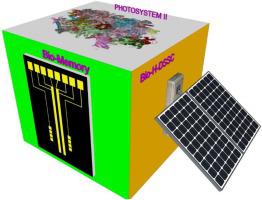Journal of Photochemistry and Photobiology A: Chemistry ( IF 4.3 ) Pub Date : 2020-07-03 , DOI: 10.1016/j.jphotochem.2020.112743 Remziye Güzel , Fatma Yediyıldız , Yusuf Selim Ocak , Filiz Yılmaz , Arzu Ersöz , Rıdvan Say

|
Chromophore–containing complexes and proteins in nature are widespread use in the area of photochemistry and as models for photosynthesis. However, when they are removed from their biological environment, the proteins undergo denaturation and are unstable. In addition, cofactors such as NADH need to be released for continuous use in the system. In order to make PSII composed of protein mixtures, chromoforms and different cofactors stable and sustainable, the use of the ANADOLUCA (Amino Acid monomer Decorated and Light Underpinning Conjugation Approach) method to combine multicomponent photo-active bio-complexes has been used for energy and bio-inspired devices.
The fabricated PSII-BNC based bio-nanodevice has boosted excellently photo-induced memory functions. To determine the stability of the particles, oxidation, reduction and OCPA potentials behavior of the PSII-BNC having a film under the light has been repeated continuously up to 109 cycles. In addition, we have developed a novel, bio-inspired and hybrid bio-dye-approach (BIO-H-DSSC) as a new generation of dye-sensitized solar cells. The bio-nanoenergetic layer formed by PSII-BNC with TiO2 has resulted in 0.22 % level of power conversion efficiency with open circuit voltage of 0.50 V, short circuit current of 888 μAcm−2 and fill factor of 0.50.
中文翻译:

基于光系统(PSII)的混合纳米鸡尾酒,用于制造BIO-DSSC和光诱导存储设备
自然界中含有发色团的复合物和蛋白质在光化学领域被广泛使用,并作为光合作用的模型。但是,当将它们从生物学环境中移出时,蛋白质会发生变性并且不稳定。另外,需要释放辅因子,例如NADH,以在系统中连续使用。为了使由蛋白质混合物,染色体形式和不同辅助因子组成的PSII稳定且可持续,使用ANADOLUCA(氨基酸单体修饰和轻质共轭方法)方法将多组分光敏生物复合物结合起来用于能量和生物启发的设备。
制作的基于PSII-BNC的生物纳米器件提高了光感应存储功能。为了确定颗粒的稳定性,已经连续重复在光下具有膜的PSII-BNC的氧化,还原和OCPA电位行为,直至10 9个循环。此外,我们还开发了一种新颖的,受生物启发的混合生物染料方法(BIO-H-DSSC),作为新一代染料敏化太阳能电池。由PSII-BNC与TiO 2形成的生物纳米能层在开路电压为0.50 V,短路电流为888μAcm -2和填充系数为0.50的情况下,产生了0.22%的功率转换效率。



























 京公网安备 11010802027423号
京公网安备 11010802027423号